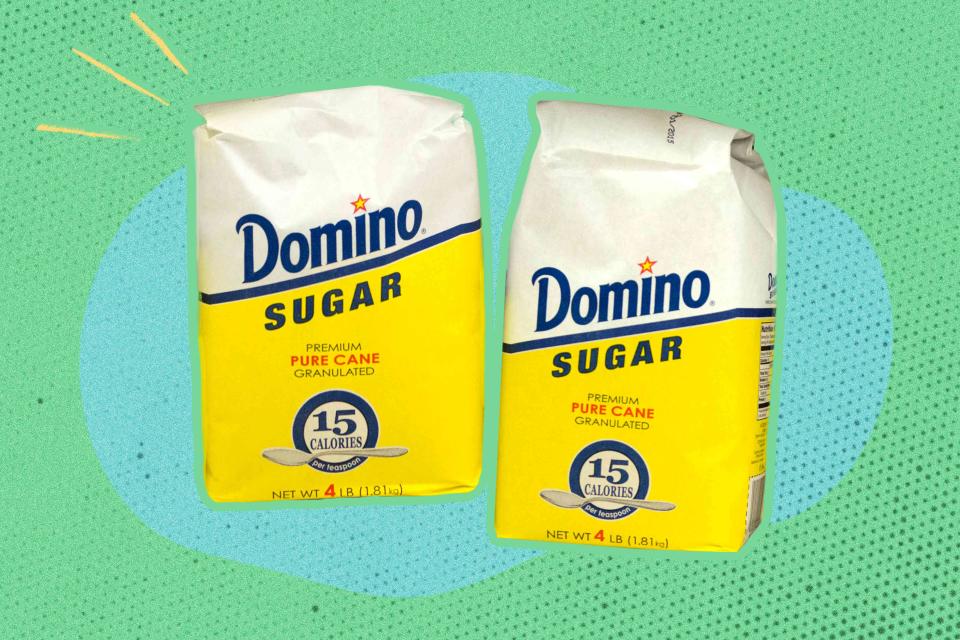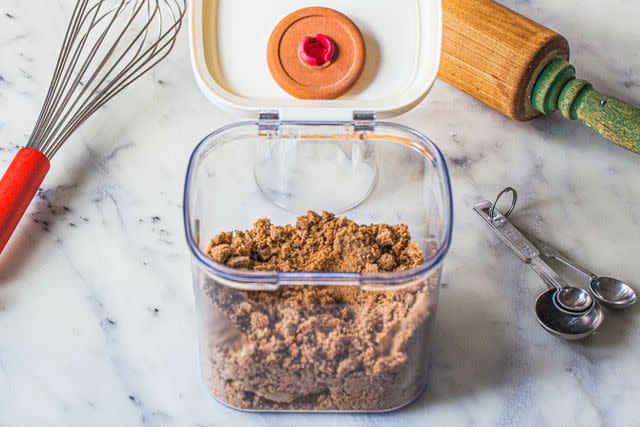The Only Way You Should Store Sugar, According to Domino
Should you store sugar in the fridge?

Simply Recipes / Photo Illustration by Wanda Abraham / Getty Images
Because I love to bake, I have an inordinate fear that I’ll run out of sugar. That's why I buy the huge bag at Costco and then realize I will have it in my pantry forever and don’t know how to store it.
So I talked to Eleonora Lahud, senior research chef at Domino Sugar, to learn the best way to store sugar to maintain its taste and quality. Lahud has a degree in food science and is a certified baker from the American Institute of Baking.
“Sugar should be stored at room temperature and tightly wrapped to avoid humidity. Granulated sugar will harden when exposed to any type of moisture,” Lahud says. “Moisture causes sugar to clump. Clumped sugar makes it difficult to work with. Never measure sugar that is clumped as it will affect the outcome of your recipe.”
She says sugar should always be stored in an airtight container. Keep it in a cool, dry place—like the pantry—because exposure to heat or sunlight may also cause it to clump.

Simply Recipes
How To Make Hard Sugar Soft Again
Don’t worry if your granulated sugar gets hard. There’s an easy fix to make it soft again.
Lahud says to preheat your oven to its lowest temperature, between 150°F to 200°F. Remove the sugar from its box or bag and put it in an oven-proof container. Then place it in the oven for about 15 minutes.
“Tap the sugar with a spoon,” Lahud says. “If it starts to fall apart, turn the oven off and leave sugar in the oven for an hour or two to completely dry out.“
How To Store and Soften Brown Sugar
Brown sugar should be kept in a cool, moist area in a covered container. For extra protection, store the original container in a second container with a tight lid. “You can also empty the sugar into a rust-proof container or a heavy, moisture-proof plastic bag and keep it tightly closed,” says Lahud, who suggests several ways to soften brown sugar that becomes hard.
Quick-ish method: If you need to use brown sugar right away, remove it from the package and place it in an oven-safe dish. Place it in a 250°F oven and as soon as the sugar softens, scoop out the amount you need immediately. The sugar will harden as it cools. Be cautious, Lahud advises, because oven-heated sugar is extremely hot.
Microwave method: Place about a half pound of hardened brown sugar in a microwave-safe bowl and cover it with two pieces of damp (not dripping) paper towels. Then tightly cover the bowl with plastic wrap. Heat it on high for 1 1/2 to 2 minutes. Break up the sugar with a fork and stir. It will harden as it cools, so use it right away.
Long-game method: If you notice your brown sugar has hardened and don’t need it ASAP, transfer it into a container that seals tightly and add a slice of bread. Alternatively, place a piece of plastic wrap or foil on top of the sugar and two pieces of a damp paper towel on top of the plastic wrap or foil. Tightly cover the container. Remove the bread or paper towels after two days, when the sugar has absorbed the moisture and is softer.
How To Store Powdered Sugar
Keep powdered sugar in a cool, dry place. If it’s exposed to moisture, then it can develop lumps. It can also absorb strong smells. “Powdered sugar cannot adequately be restored if it forms lumps because of the cornstarch used in the sugar,” explains Lahud.
Should You Store Sugar in the Refrigerator?
Absolutely not, says Lahud. “Sugar is hygroscopic, this means it can attract and retain water molecules from its surroundings,” Lahud says. The high humidity in refrigerators can cause sugar to clump.
Refrigerators often have strong odors—like last night’s leftovers or particularly pungent produce. Sugar can absorb those odors, which affects its taste and quality.
If stored correctly, granulated sugar can be used and kept indefinitely, says Lahud. The shelf life of brown sugar is also indefinite, but it’s best to use it within six months after you buy it for the best flavor.
Read the original article on Simply Recipes.


